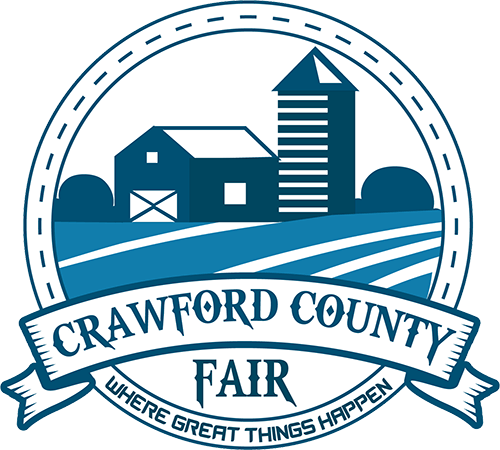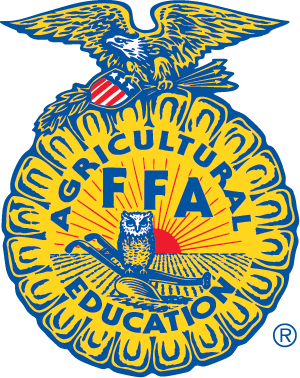The first Crawford County Fair featured ten entries of sheep and hogs, exhibited in wagons on the present courthouse ground with what little needlecraft displays on exhibit shown on the second floor of the old courthouse. The first fair was held on land, which is now on the site of the courthouse on October 19, 1848.
Officers of the Society, which was organized in the fall of 1848, included Zalmon Rowse-president, Jacob Mollenkopf- vice president, and Andrew Failor- treasurer.
The second fair was held on October 25, 1849, with the ground, which would become occupied by the Quinby block used for mostly cattle exhibits. An old advertisement announced the amount of the premiums was $103.00.
The third fair, on October 17th and 18th, 1850, became an enlarged event. The fair was more of a cattle show than a fair, and was held on grounds purchased expressly for the purpose. This site was cut nearly in half by the Ohio and Indiana Railroad and a new site was purchased along Rish Lane, now Wise St., near Oakwood Cemetery. The land contained about eight acres and a rough zig-zag curve, scarcely a quarter of a mile in length, was developed for a race track. This was the site of the fourth fair. Fairs were held there yearly, including the 14th on September 18th – 20th, 1861. After this event, no fairs were held during the Civil War.
It was to be six years before another fair would be held. When in 1867 re-establishment of a fair for Crawford County was considered, it was found the old site near the cemetery was unsuitable because it had been laid out in a pasture and the two halls had been ruined during the war. Entirely separated from the Crawford County Agricultural Society was a stock company organized by eleven men, under the name of the Crawford County Agricultural Association in 1867. Among those men were John Bremen, who had several valuable horses, and whose eighth-of-a-mile race course could still be raced in 1921. Major Edmund Kearsley of Bucyrus was also a member of the new company. The company bought eighteen acres of land on the site of the old Crawford County fairgrounds north of Lincoln Way and just east of the T. & O.C. main tracks. In 1869, nine more acres were added, and in 1871, another four acres and a half, making a total of over thirty-two acres. The Agricultural Society rented the land from the agricultural association and it was here the four-day 15th fair was held in October, 1867. The Crawford County Agricultural Society was reorganized with D.C. Boyer as president and Josiah Koler, vice-president. Both men were stockholders in the agricultural association. Christ Elliott was chosen secretary of the society and J.B. Gormly, treasurer.
Annal fairs, from the 15th through the 59th were held along the T. & O.C. Railroad. When it became a question of removal of railroad shops from Bucyrus or room for expansion, the Bucyrus Industrial Association negotiated for the formation of a company called the Bucyrus Land Company, organized to dispose of the old fairground site and provide a new place. Bucyrus newspapers reported that after considerable “wrangling”, the old Boyer farm lying just east of the old grounds and Whetstone Street, was bought from the owner, E. Yaussey, for $17,500. The purchase occurred on September 16th, 1914.
It was then the improvements to the grounds began, and are still continuing. In March and June of 1922, the society approved improvements to the fairgrounds for over $13,000. Amoung those improvements was the construction of a cattle barn at the cost of $6,043. Improvements of the grounds and construction of buildings with bonds sold for $7,000. Two years later a horse barn was constructed on the site at a cost of $7,000.
The next very significant event at the site occurred in 1942 when the fair board turned the grounds over to the commissioners. The fairgrounds was then leased to the federal government for the duration of the Second World War and for six months after for Camp Millard. On May 4th, 1946, the county commissioners approved a resolution accepting all buildings and installed equipment, plus $20,000 cash from the government for use of the fairgrounds.
On October 15th, 1946, a contract was signed to rebuild and relocate the half-mile track at the fairgrounds at a cost of $8,000. Then almost a year later, on August 20th, 1947, bonds were issued for construction of the grandstand and other buildings at a cost of $125,000. Other construction at the fairgrounds through the years has included a horse barn and pole shelter for $9,500 in 1959; a new display building for $10,000 in 1958; another pole barn in 1961 at a cost of $2,300; the Youth Building in 1974; a new restroom in 1990; a new show arena in 1992 (to replace the one burned in 1991) and a new secretary’s office in 1995. In 1955, a plaque was purchased to commemorate the fairgrounds used by Camp Millard during WWII. The base for the plaque was furnished and put in place by members of the 753rd Railroad Battalion. The latest addition to the fairgrounds is a new Ag & Expo Building, done in 2012, named the Camp Millard Agricultural & Exposition Building. It is a 100’X200′ metal building with a concrete floor that houses swine, goats and alpacas during the fair and is rented for many community events throughout the spring to the fall.




